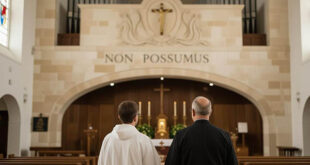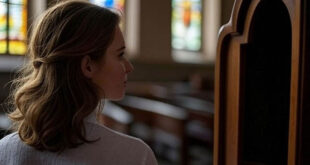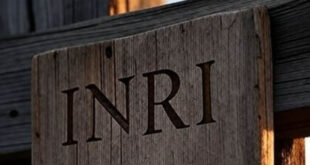An Essential Guide to Reading Scripture with Faith, Reason, and the Heart of the Church
Introduction:
A Bible in every home, a personal opinion in every soul… or confusion in every interpretation?
We live in a time when access to Sacred Scripture is abundant. From apps to digital Bibles, from social media to short videos that “explain” the Gospel, the Word of God seems more available than ever. But with this accessibility arises a big question: Are Catholics allowed —and capable— of interpreting the Bible on their own?
This is no trivial matter. It directly affects how we live our faith, how we relate to God, and how we transmit the Gospel to new generations. In this article, I invite you to discover what the Catholic Church teaches about biblical interpretation, why it is crucial to do so within a theologically sound framework, and how you can begin (or continue) today to read the Bible as an authentic Catholic—guided by Tradition, the Magisterium, and the Holy Spirit.
1. History: The Bible didn’t fall from the sky, nor is it interpreted in isolation
a. The Bible was born in the heart of the Church
One of today’s great confusions is thinking that the Bible was simply “written and published,” like any other book, and therefore anyone can pick it up and give it whatever meaning they want. Nothing could be further from the truth.
The Bible was written within the community of faith, by authors inspired by God but also guided by a living oral tradition. It was the Church that determined, centuries later, which books were truly inspired by the Holy Spirit (the so-called “canon” of Scripture). That’s why St. Augustine declared:
“I would not believe in the Gospel, were it not for the authority of the Catholic Church.”
(Against the Epistle of Manichaeus, 5,6)
b. Protestantism and private interpretation
In the 16th century, the Protestant Reformation introduced the idea of “Sola Scriptura,” meaning that the Bible is the only authority in matters of faith, and that every believer can interpret it personally, without ecclesial guidance. This quickly led to doctrinal division, as each reader formed their own interpretation. Today, there are over 30,000 Protestant denominations that interpret the Bible in contradictory ways.
The Catholic Church, on the other hand, has always maintained that the Bible must be read within the living Tradition and the Magisterium, forming an inseparable tripod: Scripture, Tradition, and the Magisterium (cf. Dei Verbum, n. 10).
2. Theology: Who can interpret the Bible? And how?
a. Does it make sense to read the Bible without the Church?
Sacred Scripture is not a secret code, nor an open novel for any opinion. It is not a self-help book or a personal spiritual diary. The Bible is the Word of God, written in human language, and therefore requires faith, prayer, formation, and humility to be correctly understood.
The Church teaches that the authentic interpretation of the Word of God has been entrusted solely to the Magisterium, that is, to the Pope and the bishops in communion with him (Dei Verbum, 10). But this does not mean that the faithful cannot—or should not—read it. On the contrary: all Catholics are called to meditate on it and be nourished by it, but in accordance with the faith of the Church.
“Sacred Scripture must be read and interpreted in light of the same Spirit by whom it was written.”
(Dei Verbum, 12)
b. Three fundamental rules for Catholic interpretation:
According to the Catechism (nn. 112–114), every Catholic reading of the Bible must follow three criteria of interpretation:
- Be attentive to the content and unity of the whole Scripture
The Bible interprets itself. You cannot isolate phrases. What one passage says must be understood in light of the whole. - Read Scripture within the living Tradition of the whole Church
The Bible was entrusted to the Church, and its understanding has grown through the centuries thanks to the saints, the Church Fathers, and the Magisterium. There is no room for “my personal interpretation” if it contradicts what the Church has always believed. - Be attentive to the analogy of faith
Every interpretation must be in harmony with the truths of faith. The Bible cannot say something that contradicts the Creed or the dogmas.
3. Practical guide: How can a Catholic read and interpret the Bible today
A. Before reading:
- Ask the Holy Spirit to enlighten you. Scripture is the living Word, and without prayer it becomes a dead letter.
- Use a Catholic Bible (such as the Jerusalem Bible, the Navarre Bible, or the Latin American Bible).
- Keep the Catechism handy: it will help you understand many teachings in the light of faith.
B. While reading:
- Start with the Gospels. They are the life of Jesus, the center of all Scripture.
- Read in context. Don’t stop at a single verse. Read the whole chapter.
- Consult reliable commentaries. There are excellent study guides, like those by Scott Hahn or the Church Fathers.
C. After reading:
- Meditate: What is God saying to me today? How can I live this concretely in my life?
- Apply: Who can I bring this Word to? The Bible is not only to illuminate your soul but to transform your environment.
- Share with other believers: in Bible groups, parishes, or prayer circles.
4. The role of the Magisterium and Catholic scholars
Many Catholics wonder whether they can trust modern biblical studies. The answer is: yes, if they are in communion with the Church.
The Second Vatican Council strongly encouraged the serious study of Scripture in a Catholic key. Biblical institutes were founded, original texts were translated, and theologians were trained with rigor and fidelity. Thanks to this, today we have access to a faithful, profound, and enriching interpretation.
Pope Benedict XVI, a great lover of the Word, once said:
“Christianity is not a religion of the book, but of the living Word.”
(Verbum Domini, n. 7)
5. Common mistakes we must avoid
❌ Thinking everyone can have “their own truth” when reading the Bible
Truth is not multiple. The correct interpretation is the one that coincides with the Catholic faith, not just what “I feel” it means.
❌ Using the Bible to justify ideologies or errors
Many manipulate biblical texts to defend their preexisting ideas (radical feminism, gender ideology, moral relativism, etc.). This is not faithful interpretation, but rather the instrumentalization of the Word of God.
❌ Rejecting the Old Testament
The entire Bible is inspired. The Old Testament is not “outdated” or useless. It is the promise fulfilled in Christ.
6. Practical applications in daily life
- As parents: read the Bible with your children. Talk about the parables, the psalms, the miracles. Make the Word present at home.
- As catechists or evangelizers: don’t just teach “stories,” but the profound message God wants to convey.
- As young people: don’t seek only motivation in isolated quotes. Go deeper, study, let Christ speak to you through every page.
- As elderly or sick: the Bible is consolation, strength, hope. “Your words, Lord, are spirit and life” (John 6:63).
7. Key Bible verse for reflection
“All Scripture is inspired by God and is useful for teaching, rebuking, correcting and training in righteousness, so that the man of God may be perfect, fully equipped for every good work.”
(2 Timothy 3:16–17)
Conclusion:
The Bible is not a closed book. But neither is it a jungle without a map.
Yes, Catholics can interpret the Bible, but never as isolated individuals, rather as living members of the Body of Christ, which is the Church. Scripture is understood in faith, lived in charity, and safeguarded with the authority Christ gave to Peter.
Now more than ever, we need biblically formed Catholics, spiritually on fire and ecclesially faithful. Do not be afraid of the Bible. Love it, read it, study it… but never read it outside the heart of the Church.






